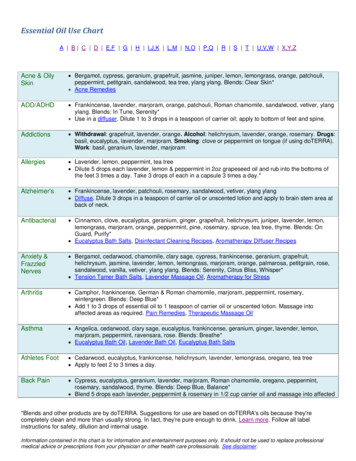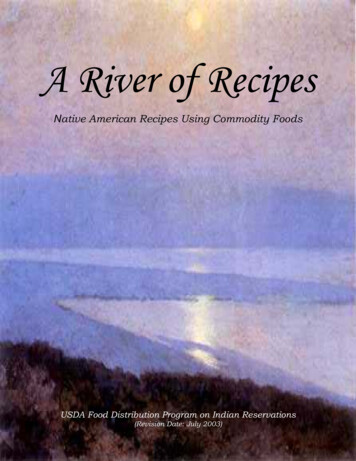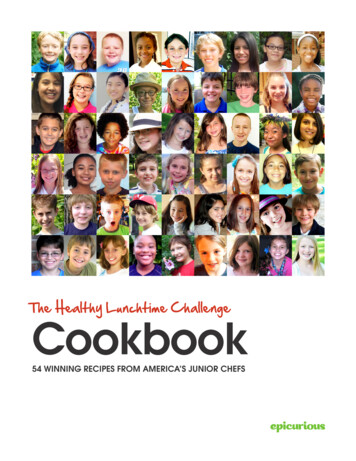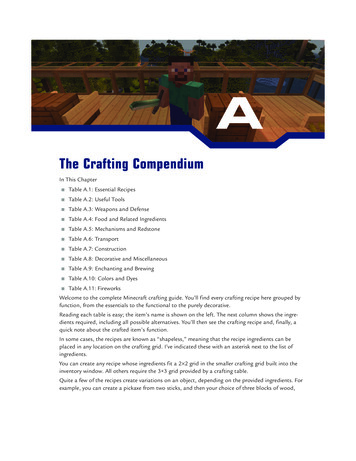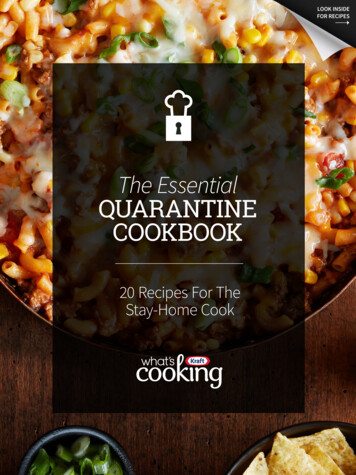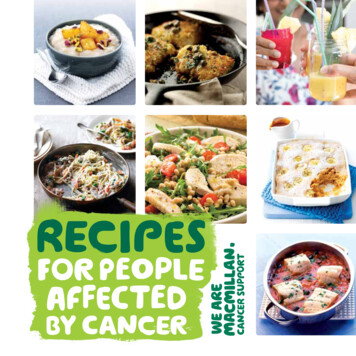
Transcription
HelloThis booklet is part of a series of booklets on diet and cancer. The other booklets in theseries are: Eating problems and cancer Healthy eating and cancer The building-up diet.These are also available as audiobooks.Check with your cancer doctor, nurse or dietitian about which of these books are rightfor you. It is also important to check whether you need any additional information.If you would like to order any of these booklets, you can contact our cancer supportspecialists on 0808 808 00 00. They can send you the information you need.Priti (middle) and her friends, Deepti(left) and Mitta (right), enjoying ourMacmillan coco kahona mocktail(see page 86 for recipe).
ContentsYour key 2About this recipe book 3Dietary needs when you have cancer 4Choosing a recipe 6Adapting the recipes 9Cooking the recipes 10Recipe index 11Starters and snacks 15Main courses 37Desserts 65Drinks and smoothies 81Further information 911
Your keyWe have added the following symbols to the recipes,so you can quickly find the ones that may suit you.These are a guideline only and you should talk to your doctoror dietitian about which foods are suitable for you. This keyis also on the bookmark on the back cover.You can search for recipes by looking for each symbolin the index on pages 11 to 14.Suitable for people witha dry or sore mouthHealthier-eating recipeSuitable for people withsickness or nauseaVegetarian recipeSuitable for people withproblems chewingSuitable for freezingSuitable for people with lossof taste or smellDo not freezeSuitable for people with lossof weight or appetite2
About this recipe bookWho is this book for?Where are the recipes from?When you are affected by cancer,you may not feel like eating. But it isimportant that you do. The recipes inthis book have been designed for peoplewith cancer who have eating problems.Many of the recipes include ingredientsthat are high in fat or sugar, to helpyou get enough energy and maintainyour weight during cancer treatment.They are designed to be appetisingand to encourage you to eat,even when you don’t feel like it.This book has been planned and writtenwith food experts, including dietitians.The original version was put togetherwith help from celebrity chef BrianTurner, and some of his creationsare in this book.Most of the recipes are simple andquick to prepare. This is to make itas easy as possible to cook when youare not feeling well. Hopefully they willhelp you rediscover some enjoymentin eating tasty, nutritious food.If you are eating well and want to loseor maintain weight, there are somehealthier-eating recipes in this book.Our booklet Healthy eating andcancer may also be helpful for you.Other recipes have kindly beencontributed by a number of people andorganisations, including BBC Good Food,Canned Food UK, CaribbeanPot.com,NHS Choices, the Oesophageal PatientsAssociation and Waitrose. Some of theserecipes have been adapted to makethem more suitable for people affectedby cancer.Further informationIf you would like to talk aboutany of the information in this book,you can call our cancer supportspecialists on 0808 808 00 00.They can give you information abouteating problems and answer anyquestions you have.See pages 97 to 100 for a list of otheruseful organisations and resources.3
Dietary needs when youhave cancerWhen you have cancer, your dietary needs may change.You may have lost weight, or you may find it difficult to eat.Extra caloriesDuring treatment, it is important to tryto maintain your weight. This helps youto stay strong and cope better with theside effects of cancer and its treatment.People who find it difficult to eat enoughmay need extra calories. Your doctoror dietitian may recommend you eatfoods that you would normally thinkof as unhealthy.For recipes that are high incalories, look out for this symbol.We also have a list of tips for addingextra energy to your food on page 9.If you are struggling to eat enough tomaintain your weight, our bookletThe building-up diet may alsobe useful.If you are overweight, try to avoid rapidweight loss. This is because muscle isusually lost as well. Muscle is important tomaintain your strength during treatment.4If you want to follow a healthy diet,you can find out more in our bookletHealthy eating and cancer.Ready mealsIf you find you are too tiredto prepare and cook food, havingready meals can be the easiestway to get enough calories.There are many options available,from ready-made pasta and curry saucesto tinned vegetables and microwavablemeals. It is a good idea to have someof these ready meals in your freezerand cupboards before treatment starts.Adding side portions of vegetables willbulk up the meal and increase yourintake of vitamins and minerals.
Lizzy (left) and Patricia (right)preparing our Fruit smoothierecipe (see page 84).
Choosing a recipeEating problemsSome people with cancer developproblems that affect their ability to eat.These problems may be a result of thecancer or its treatment.If you have a dry or soremouth, you may need to avoiddry foods and add sauces orgravies. Creamy foods may be easierto eat. If your mouth is sore, you shouldalso avoid foods that are spicy, acidic orsalty. These include chilli peppers, citrusfruits and tomatoes. We can send youmore information about looking afteryour mouth during treatment. In thisbook, look for recipes with this symbol.If you have problems chewing,try eating softer foods. Cut all theingredients into small slices orchunks. Adding sauces or gravies mayalso help the food go down. You mayneed to use a liquidiser or blenderfor some dishes. In this book, look forrecipes with this symbol.6If you have lost your senseof taste or smell, you may wantto eat foods that have strongerflavours or spices. You can add extraspices to the recipes in this book,or try the recipes with this symbol.If you are feeling sick, it mayhelp to eat bland or dry foods.Many people find they need toavoid creamy or spicy foods. Foods thatmake one person feel sick might befine for someone else. This means thatsome of the recipes we have labelled assuitable for people with sickness may notbe suitable for you. These recipes havethis symbol.Some people may have a biggerappetite due to medicines theyare taking. In this case, it isimportant to eat lower-calorie foodsso you don’t put on too much weight.Look for recipes with the healthiereating symbol. You can also adaptthe recipes to reduce the fat content,for example by using skimmedmilk instead of cream. Our bookletHealthy eating and cancer has moreinformation on following a healthy diet.There is also an index of recipes orderedby eating problem on pages 11 to 14.
The recommendations in this book area guideline only. Talk to your doctor ordietitian about the foods that are suitablefor your needs. You can also try differentrecipes to find out what works well foryour taste.Our booklet Eating problems andcancer has more useful tips. It alsohas advice on which foods to eat andwhich to avoid if you have constipationor diarrhoea.Low immunityIf your immunity is very low, youshould ask your doctor or dietitianabout whether there are any foods youneed to avoid. They may recommendthat you avoid: c heeses made from unpasteurisedmilk, such as brie blue-veined cheeses, such as stilton shellfish, such as prawns and mussels raw or undercooked meat raw fish, such as sushi liver pâté and fish paste live bacterial yoghurt raw or undercooked eggs uncooked herbs, spices, pepperand peppercorns.It is also important to be careful withfood hygiene when you are cooking(see page 10).Other health conditionsSome people with cancer may havedietary needs or eating problems that arenot covered in this book. For example: p eople with diabetes, kidney diseaseor heart disease people who have a colostomyor an ileostomy people who have had all or partof their stomach or bowel removed people who have had radiotherapyto their mouth or jaw.These people may need to followa special diet designed for them.You can ask your doctor, specialistnurse or dietitian for advice aboutdiets for these conditions.Tip If you have problemsswallowing, speak to yourhealthcare team. A speechand language therapist cantell you which foods andrecipes are suitable for you.7
Trevor (left) and Conor (right)preparing our Chicken curryrecipe (see page 49).
Adapting the recipesAdding extra energyIf you are losing weight or havea poor appetite, it is important tochoose high-energy foods to getenough calories. Look out for this symbolin this book.Here are some tips to add energyto meals: W hen you are at the supermarket,choose full-fat foods instead of ‘diet’,‘low fat’ or ‘light’ foods. Fry your foods in oil or ghee(a type of butter). Add extra butter, margarineor oil to bread, potatoes,pasta and cooked vegetables. Add extra cheese to sauces and extrapaneer (a type of cheese) to curries. Add cream, sour cream, plainyoghurt, mascarpone or crème fraîcheto sauces, soups and meat dishes. Add whole or blended beans,lentils or peas to curries and stews. Add evaporated milk, condensed milkor cream to desserts and hot drinks. Have cream or ice-creamwith desserts. Add peanut butter, chocolate spread,tahini, honey or jam to bread, toast,crackers and biscuits.Our booklet The building-up diethas more information on maintainingyour weight when you have a poorappetite or eating difficulties.If you are still struggling to maintainyour weight, your doctor, nurse ordietitian may suggest that you takesupplements. These will help get moreprotein or energy (or both) into yourdiet. They are usually available onprescription. You can take them as drinksor snacks between meals, or add themto food.AllergiesThe recipes in this book don’t need tobe followed exactly. If you are allergicto certain ingredients, such as milk,nuts or shellfish, you can use somethingdifferent. Just remember that changingthe ingredients will change the nutritionalinformation for that recipe.If you don’t eat dairy products, you can: r eplace milk with soya, oat, rice,hazelnut, almond or coconut milk replace cream with coconut cream replace butter with non-dairy spreads replace yoghurt with soyaor coconut yoghurt.9
Cooking the recipesFood hygieneIf your immune system is weak, you aremore at risk of getting food poisoning.You may also be less able to cope withthe symptoms of food poisoning.To reduce this risk, you should: use fresh ingredients use foods before their use-by date wash your hands before youtouch food keep pets out of the kitchen wash all fruit and vegetables wellin cold, running water – do notsoak them, unless you are usingdried lentils or beans clean cooking utensils and choppingboards thoroughly wipe worktops with hot, soapy wateror an anti-bacterial spray, particularlyafter you have prepared raw meator eggs ensure food (especially meat)is cooked through and veryhot before serving avoid reheating food more thanonce (see information oppositeon freezing and reheating leftovers) wash or replace dishcloths andtea towels regularly.10For more information about foodhygiene, visit g leftoversMost leftovers can be safely stored forat least 1 to 2 months. If you decideto store food to eat later, let it cool downcompletely, then store it in the freezerin serving-size portions. Making a largequantity and freezing individual portionsis a useful thing to do before yourtreatment starts. This will save youtime and energy on days that youdon’t feel like cooking.Remember to defrost your foodsthoroughly before reheating them.This is especially important if youhave low immunity due to treatment.Only reheat food once and makesure it is piping hot right throughbefore you eat it. Take care notto burn your mouth or tongueif you are reheating food.Warning Due to the high risk ofbacteria in cooked rice, always preparefreshly cooked rice to have with a meal.Do not reheat rice.
Recipe indexPageStarters and snacksCaribbean-styletuna spread17Sweet potato crab cakes18Smoked fish chowder21Chicken and whitebean salad22Sardine bruschetta25Minestrone soup26 Watercress and leek soup27 Minty summer rice salad28Tomato and basil soup30Bean dip 31 Parsnip and coconut soup33 Paneer bhujiya34 Hearty vegetable soup35 Easy lentil soup36 11
PageMain courses12Cod Viennoise39 Salmon curry40 One-pot fish with blackolives and tomatoes42 Tuna and vegetablespaghetti45 Spring onion, garlicand prawn risotto46 Chicken curry49 Quick shepherd’s pie50 Speedy Moroccanmeatballs53 Chilli con carne54Paneer curry55Butternut squash, leekand parmesan risotto56Red lentil, sweet potato,carrot and kale stew58
PageTarkarir dhal59Spring vegetable casserole60Mixed bean Mexican chilli63Red spaghetti64 DessertsSummer pudding67 Greek honey cheesecakewith apricot compote68 Brown sugar plums withsour cream71Chunky chocolate andsour cherry muffins72Stuffed baked apples73 74 77 Amaretti stuffed peaches78 Chocolate goo80Microwave bananapuddingCoconut and cardamomrice pudding 13
PageDrinks and smoothies14Banana, honey andhazelnut smoothie83 Fruit smoothie84Macmillan coco kahona86Citrus fizz88Macmillan autumn punch89 Watermelon wonder90
Great if you fancy something lighterIf you are struggling with sickness, a lighter snackmay be a good option. Soups are great if you haveproblems chewing. If you are underweight or needto increase your energy intake, choose recipes withover 400 calories per portion. Or try some of thetips on page 9 to add extra energy.
Preparation 15 minutesServes216Nutritional information per portion (without bread, crackers or bakedpotato) Energy 270kcal, Protein 31.9g, Total fat 14g (of which saturates 2.2g),Carbohydrate 4.2g, Fibre 2.2g
Caribbean-style tuna spreadIngredientsMethod 1 Open the tins of tuna and squeezethe liquid out.2 Flake the tuna into small piecesin a large bowl. Don’t overworkit or it will become mushy.3 Add all the ingredients, except theavocado and lemon juice. Mix well.4 Add in the avocado and lemon juice.Gently fold in the avocado, takingcare not to crush it.5 Adjust the seasoning or add morelemon juice to taste.6 Serve the mixture in a sandwich,on crackers or on a baked potato. 2 tins of tuna (200g each), drained1 small red onion, finely diced1 spring onion, chopped1 small stalk of celery, finely diced Cucumber (4 tablespoons),finely diced 1 red or yellow pepper, finely diced(optional)Black pepper Caribbean hot pepper sauce(half a teaspoon) (optional) Mayonnaise (1 tablespoon)Half an avocado, diced Lemon juice (1 and a halfteaspoons)Thanks to CaribbeanPot.com for contributing this recipe.Tips Make the spread in advance and store in the fridge. It will last for a coupledays in a sealed container. If you have a sore mouth or don’t like spicy food, leave out the Caribbeanhot pepper sauce. You can buy this sauce with different levels of spice.17
Sweet potato crab cakesIngredientsMethod S weet potato (450g), peeled andcut into chunks 1 spring onion, chopped Half a small red onion, finely chopped Salt and black pepper Dried thyme (a quarterof a teaspoon) Fresh parsley (1 tablespoon),chopped Half a scotch bonnet chilli pepper,deseeded and finely diced (optional) Mayonnaise (1 tablespoon) 1 tin of crabmeat (120g), drained Breadcrumbs (120g), naturalor golden Vegetable oil (1 tablespoon)1 Cook the sweet potato in boilingwater until tender. Drain it and mashit in a deep bowl.2 When the sweet potato is cool,add all the ingredients except thecrabmeat, breadcrumbs andvegetable oil. Mix well.3 Squeeze the water from the crabmeatand fold into the mixture. Chill in thefridge for about 20 minutes.4 Roll the mixture into balls (about thesize of a golf ball). Then roll the ballsin the breadcrumbs, pressing downgently so the crumbs stick. Put themin the fridge for 10 minutes to firm up.5 In a wide pan, heat the vegetable oilover a medium heat. Press down oneach crab cake ball to make a patty.Fry them on each side until goldenbrown, then drain them on kitchenpaper to absorb the extra oil.Warning Scotch bonnets are hot!If you have a sore mouth, leave it out.If you like less heat, use a bird’s eyechilli instead.18Tips Use wholemeal breadcrumbs to increase the fibre content. To reduce the fat content, use an egg white instead of mayonnaiseand grill the cakes instead of frying.
Preparation 10 minutesCooking35 minutes (plus 30 minutes chilling)Serves4Thanks to CaribbeanPot.com for contributing this recipe.Nutritional information per portion Energy 379kcal, Protein 11.2g,Total fat 17.4g (of which saturates 2.2g), Carbohydrate 45.8g, Fibre 4g19
Preparation 15 minutesCooking30 minutesServes420Nutritional information per portion Energy 379kcal, Protein 25.9g,Total fat 19.2g (of which saturates 11.6g), Carbohydrate 27.6g, Fibre 3.1g
Smoked fish chowderIngredientsMethod 1 Boil 1 litre (about 2 pints) of water,then reduce the heat to simmer.Add the haddock to the water andcook for about 10 minutes until tender.2 Drain the haddock, keeping the waterto use later as a stock. Roughly flakethe haddock, getting rid of theskin and bones.3 Heat the butter in a pan. Add theonion and fry until soft. Stir in theflour and cook for 1 minute.4 Gradually add the stock and bringto the boil, stirring constantly.Add the potatoes and carrotsand simmer for about 10 minutesuntil tender.5 Stir in the flaked fish and cream.Finish with a pinch of salt and blackpepper, then serve.Smoked haddock fillet (450g)Butter (55g)2 medium onions, finely choppedFlour (2 level tablespoons) Potatoes (225g), peeled andfinely chopped Carrots (170g), peeled andfinely chopped Single cream (140ml) Salt and black pepperThanks to the Oesophageal PatientsAssociation for contributing this recipe.Tips If you have problems chewing, liquidise the soup in a blenderor food processor (and sieve if necessary). Then reheat it, withoutboiling, before serving. To make it more varied and easier to prepare, use a fish pie mix insteadof the haddock.21
Chicken and white bean saladIngredientsMethod 1 tin of haricot beans (400g),rinsed and drained Olive oil (3 tablespoons) Wholegrain mustard (1 tablespoon) Zest and juice of a lemon Rocket leaves (70g) 2 cooked chicken breasts, sliced 8 cherry tomatoes, quartered1 Whisk the oil with the mustardand lemon zest and juice.2 Drizzle half of the dressing over thebeans in a bowl. Gently toss to coat.3 Divide the rocket between two servingdishes and then scatter with the beans.4 Add the chicken and tomatoesand then drizzle over theremaining dressing.5 Finish with a pinch of salt and blackpepper, then serve.Thanks to Canned Food UK for contributing this recipe.22
Preparation 10 minutesServes2Nutritional information per portion Energy 501kcal, Protein 40g,Total fat 28g (of which saturates 4g), Carbohydrate 24g, Fibre 9g23
Preparation 10 minutesCooking6 minutesServes424Nutritional information per portion Energy 221kcal, Protein 14.2g,Total fat 9.3g (of which saturates 2.2g), Carbohydrate 21.3g, Fibre 2g
Sardine bruschettaIngredientsMethod 1 tin of peeled plum tomatoes (400g),drained and roughly chopped 1 red onion, finely chopped 2 garlic cloves, crushed Large handful of fresh basil,finely chopped Olive oil (1 tablespoon) Salt and black pepper 2 bread rolls 2 tins of sardines in tomato sauce(240g)1 Preheat the oven to 220 C/200 C fan/gas mark 7.2 Put all the ingredients, exceptthe bread rolls and sardines,in a large bowl. Mix thoroughly.3 Cut the rolls in half and placein the oven for 2 minutes.4 Remove the rolls from the ovenand spoon the mixture over thetop of each roll.5 Put the sardine fillets on to eachroll and place back in the ovenfor 4 minutes. Serve warm.Thanks to Canned Food UK for contributing this recipe.Tip If you have a dry or sore mouth, try serving the mixture with pastaor on a baked potato instead.25
Preparation 10 minutesCooking35 minutesServes4Minestrone soupIngredientsMethod 1 Put the oil, onion, carrot and celeryin a pan and heat gently for10 minutes, stirring occasionally.2 Add the chopped tomatoes, stock,beans and frozen vegetables. Bringthe pan to the boil and add the pasta.3 Reduce the heat to a simmer andcover the pan with a lid. Continuecooking, stirring occasionally,for about 15 minutes or until thevegetables and pasta are soft.4 Add the tomato puree. Finish with theherbs and a pinch of black pepper. Vegetable oil (1 tablespoon)1 large onion, chopped1 large carrot, peeled and chopped1 stick of celery, chopped1 tin of chopped tomatoes (400g) 1 small tin of beans, such ascannellini, kidney, borlotti orpinto beansDry pasta, any shape (50g)Frozen, mixed vegetables (100g) Vegetable stock (1 litre/2 pints)Tomato puree (a quarter of a tube)A pinch of dried mixed herbsBlack pepperThanks to NHS Ayrshire and Arran for contributing this recipe.Nutritional information per portion Energy 391kcal, Protein 15.1g,Total fat 10.5g (of which saturates 3g), Carbohydrate 61.4g, Fibre 11.9g26Tip If you have problems chewing, use a hand blender or liquidiser to makethe soup smooth.
Preparation 10 minutesCooking35 minutesServes4 to 6Watercress and leek soupIngredientsMethod Leeks (450g), washed and chopped 2 handfuls of watercress, destalkedand chopped 2 medium potatoes, peeledand chopped Butter (55g) Vegetable stock (840ml/1.5 pints) Double cream (140ml) Salt and black pepper Watercress leaves,to garnish (optional)1 Melt the butter in a large pan.Add the leeks, potatoes andwatercress. Stir well.2 Add a good pinch of salt. Then coverthe pan and cook the vegetables overa low heat for about 20 minutes,stirring occasionally.3 Add the stock and bring to simmeringpoint. Cover and simmer for a further10 to 15 minutes until the vegetablesare tender.4 Remove from the heat and allowto cool.5 Liquidise the cooled soup witha food processor or blender,then return it to the pan.6 Stir in the cream, season with saltand pepper to taste and reheat gently.7 Garnish with watercress leavesand serve.Tips Leave the soup in the fridgeovernight to improve the flavours. To reduce the fat content,swap the double cream for semiskimmed milk or half-fat crèmefraîche. If you need to thickenthe sauce, add a couple ofteaspoons of cornflour to thesauce and stir well.Nutritional information per portionEnergy 275kcal, Protein 4.4g,Total fat 21.2g (of which saturates 12.9g),Carbohydrate 18.1g, Fibre 3.3g27
Minty summer rice saladIngredientsMethod Long-grain rice (250g) Asparagus (250g), chopped intobite-sized pieces 1 red pepper, deseeded and chopped Olive oil (3 tablespoons) Grated zest and juice of 1 lemon Mozzarella (250g), cut intosmall pieces Large bunch of mint, chopped Salt and black pepper1 Add the rice to a pan of boiling,salted water and cook for 10 minutes.2 Add the asparagus and cookfor 3 to 4 minutes until the riceis completely cooked and theasparagus is slightly crunchy.3 Drain into a sieve and hold undercold, running water until cool.4 When the rice is cold, stir in the restof the ingredients.5 Finish with a pinch of salt and blackpepper, then serve.Thanks to Good Food magazine for contributing this recipe.28
Preparation 5 minutesCooking20 minutesServes4Nutritional information per portion Energy 506kcal, Protein 22g,Total fat 23g (of which saturates 10g), Carbohydrate 58g, Fibre 1g29
Preparation 2 minutesCooking5 to 10 minutesServes2Tomato and basil soupIngredientsMethod 1 tin of condensed cream of tomatosoup (295g) Single cream or crème fraîche(150ml) Pesto (1 tablespoon) Croutons (28g) Sprinkling of grated parmesan cheese 2 to 3 fresh basil leaves1 Pour the tomato soup into a pan.2 Add the cream or crème fraîcheand pesto and heat gently,stirring constantly. Don’t let thesoup boil.3 Once the soup is warm, pour itinto soup bowls and sprinkle eachone with croutons and gratedparmesan cheese.4 Serve with basil leaves.Thanks to Nutricia Clinical Care for contributing this recipe.Nutritional information per portion Energy 440kcal, Protein 7.7g,Total fat 33g (of which saturates 12g), Carbohydrate 30g, Fibre 1.7g30Tip If you want to reduce fat content, swap the cream or creme fraichefor semi-skimmed or skimmed milk. You can also leave out the croutonsand cheese.
Preparation 10 minutesCooking10 minutesServes4Bean dipIngredientsMethod 1 tin of beans, such as kidney,cannellini, butter, borlotti or pintobeans (400g) Olive oil (1 tablespoon) Grated zest and juice of 1 lemon Tahini or smooth peanut butter(1 tablespoon) 1 garlic clove, crushed Salt and black pepper1 Drain the beans and rinse well in cold,running water.2 Blend the beans into a paste usinga food processor or hand blender.Put the bean paste in a mixing bowland add the rest of the ingredients.Stir everything together well.3 Serve on a baked potatoor crusty bread.Thanks to the Oesophageal Patients Association for contributing this recipe.Nutritional information per portion (without crusty bread or bakedpotato) Energy 162kcal, Protein 5.9g, Total fat 11.7g (of which saturates 1.7g),Carbohydrate 8.3g, Fibre 2.9gTip If you want to make the dip a bit softer, add some water and mix well.31
Preparation 15 minutesCooking45 minutesServes4 to 632Nutritional information per portion Energy 365kcal, Protein 5g,Total fat 25.3g (of which saturates 16.9g), Carbohydrate 32.2g, Fibre 9.3g
Parsnip and coconut soupIngredientsMethod 1 Heat the olive oil in a large pan.Add the onion, garlic, ginger andgaram masala. Gently fry the mixturefor 3 to 5 minutes, until the onionsbegin to soften but not brown.2 Add the parsnips and mix well withthe other ingredients to bring outall the flavours.3 Pour the coconut milk and stock intothe pan. Season with salt and pepperand bring the soup to the boil.Stir well.4 Reduce the heat to a gentle simmerand cook with the lid on for30 minutes.5 Check the parsnips are soft bypiercing through to the centre witha sharp knife. Remove the soup fromthe heat and blend to a smooth pureewith a blender or food processor.6 Finish with a pinch of salt and blackpepper, then serve. Olive oil (2 tablespoons)1 large onion, chopped1 garlic clove, finely chopped Fresh ginger (25mm/1 inch),peeled and choppedGaram masala (1 tablespoon) 6 parsnips (about 600g),roughly choppedFull-fat coconut milk (500ml/1 pint) Vegetable stock (1 litre/2 pints)Salt and black pepperThanks to the Oesophageal PatientsAssociation for contributing this recipe.Tip To lower the fat content, use low-fat coconut milk.33
Preparation 5 minutesCooking15 minutesServes2 to 3Paneer bhujiyaIngredientsMethod 1 Heat the oil in a karahi, wok or fryingpan over a medium heat and fry theonion and garlic for a few minutes.2 Add the paneer, turmeric and salt.Fry for 3 to 4 minutes, stirringcontinuously.3 Add the pepper and tomato.Continue to cook for 4 to 5 minutes.4 Add the chillies and coriander leaves.Mix and remove from the heat.5 Serve with toast or chapati.Oil (2 tablespoons)1 medium onion, chopped2 garlic cloves, crushedPaneer (200g), cut into small piecesTurmeric (half a teaspoon)Salt (half a teaspoon)1 red pepper, deseeded and chopped1 medium tomato, chopped1 to 2 green chilliesHandful of fresh coriander leavesThanks to Sumana Ray for contributing this recipe.Nutritional information per portion (without toast or chapati)Energy 341kcal, Protein 15.7g, Total fat 26.3g (of which saturates 12.7g),Carbohydrate 11.4g, Fibre 2.8g34Tips This is often served as a breakfast in North India. If you can’t find paneer,try using tofu or another cheese, such as halloumi. If you have a sore mouth, leave out the chillies.
Preparation 15 minutesCooking30 minutesServes6Hearty vegetable soupIngredientsMethod 1 Heat the oil in a large pan. Add theonion, carrots, leek and celery and fryuntil sizzling. Reduce the heat, coverand cook gently for 5 minutes,stirring if needed.2 Add the tomatoes, stock, tomatopuree, beans and frozen peas.Raise the heat to the maximumto continue boiling. Add the pasta,herbs and pepper.3 Reduce the heat and simmerfor 15 minutes or until the pastais cooked, stirring frequently tomake sure the pasta doesn’t stick. Vegetable oil (half a tablespoon)1 medium onion, sliced2 small carrots, peeled and sliced1 leek, sliced2 sticks of celery, sliced1 tin of chopped tomatoes (400g) Vegetable stock (1 litre/2 pints) Tomato puree(1 and a half tablespoons)Green beans (80g)Frozen peas (80g)Dry pasta (50g) Dried mixed herbs(1 and a half teaspoons)Black pepperThanks to NHS Choices for contributing this recipe.Nutritional information per portion Energy 78kcal, Protein 3.6g,Total fat 1.9g (of which saturates 0.3g), Carbohydrate 12.9g, Fibre 2.9gTips If you like your soup spicy, add 1 to 2 teaspoons of curry powderalong with the tomatoes. For extra calories, add grated hard cheese.35
Preparation 15 minutesCooking40 minutesServes4Easy lentil soupIngredientsMethod D ried red split lentils (200g),rinsed well in cold, running waterand drained 1 large onion, roughly chopped 2 garlic cloves, crushed 2 bay leaves Dried thyme (1 teaspoon) Vegetable stock or chicken stock(1 litre/2 pints) 1 tin of chopped tomatoes (400g) Salt and black pepper1 Put all the ingredients, except the saltand pepper, in a large pan and bringto the boil. Boil for 5 minutes.2 Reduce the heat to a gentle simmer.Cover the pan with a lid and cookgently for 20 minutes, until the lentilshave softened. Stir occasionally to stopthe lentils from sticking to the bottomof the pan.3 Finish with a pinch of salt and blackpepper, then serve.Thanks to the Oesophageal Patients Association for contributing this recipe.Nutritional information p
This booklet is part of a series of booklets on diet and cancer. The other booklets in the series are: . About this recipe book 3 Dietary needs when you have cancer 4 Choosing a recipe 6 . preparing our Fruit smoothie recipe (see page




